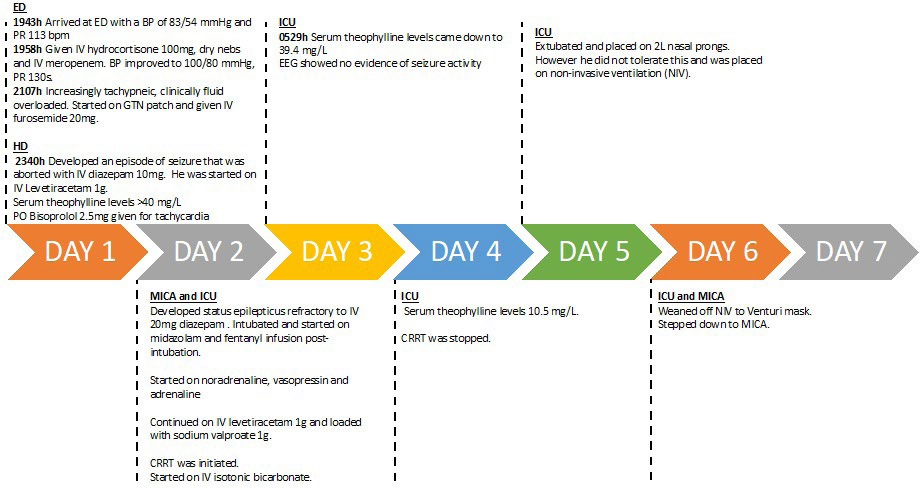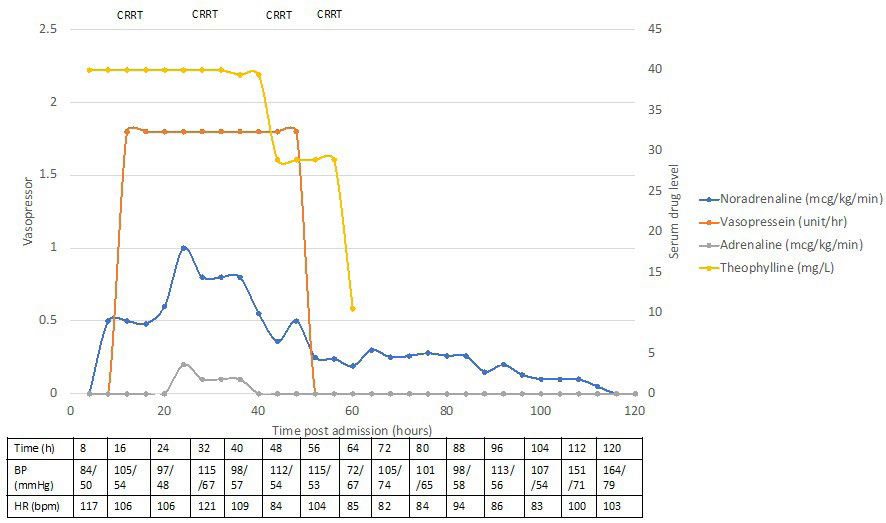1. Tripathi KD. Drugs for cough and bronchial asthma. In: Essentials of Medical Pharmacology. 2018. doi: 10.5005/jp/books/10282_18
2. Journey JD, Bentley TP. Theophylline toxicity. StatPearls. Published December 3, 2021.
3. Paloucek FP, Rodvold KA. Evaluation of theophylline overdoses and toxicities. Ann Emerg Med. 1988; 17(2): 135-144. doi: 10.1016/s0196-0644(88)80299-3
4. Sessler CN. Theophylline toxicity: Clinical features of 116 consecutive cases. Am J Med. 1990; 88(6): 567-576. doi: 10.1016/0002- 9343(90)90519-j
5. Shannon M. Predictors of major toxicity after theophylline overdose. Ann Intern Med. 1993; 119(12): 1161-1167. doi: 10.7326/0003- 4819-119-12-199312150-00002
6. Litovitz TL, Smilkstein M, Felberg L, Klein-Schwartz W, Berlin R, Morgan JL. 1996 annual report of the American Association of Poison Control Centers Toxic Exposure Surveillance System. Am J Emerg Med. 1997; 15(5): 447-500. doi: 10.1016/s0735- 6757(97)90193-5
7. Gummin DD, Mowry JB, Beuhler MC, et al. 2019 Annual Report of the American Association of Poison Control Centers’ National Poison Data System (NPDS): 37th Annual Report. Clin Toxicol (Phila). 2020; 58(12): 1360-1541. doi: 10.1080/15563650.2020.1834219
8. Global Initiative for Asthma. Global Strategy for Asthma Management and Prevention. 2021. Web site. www.ginasthma.org. Accessed December 7, 2021.
9. Vestbo J, Hurd SS, Agustí AG, et al. Global strategy for the diagnosis, management, and prevention of chronic obstructive pulmonary disease: GOLD executive summary. Am J Respir Crit Care Med. 2013; 187(4): 347-365. doi: 10.1164/rccm.201204-0596PP
10. Perry H. Theophylline poisoning. 2020. Web site. https:// www.uptodate.com/contents/theophylline-poisoning. Accessed December 7, 2021.
11. Amin DN, Henry JA. Propranolol administration in theophylline overdose. Lancet (London, England). 1985; 1(8427): 520-521. doi: 10.1016/s0140-6736(85)92121-x
12. Seneff M, Scott J, Friedman B, Smith M. Acute theophylline toxicity and the use of esmolol to reverse cardiovascular instability. Ann Emerg Med. 1990; 19(6): 671-673. doi: 10.1016/s0196- 0644(05)82474-6
13. Demiselle J, Fage N, Radermacher P, Asfar P. Vasopressin and its analogues in shock states: A review. Ann Intensive Care. 2020; 10(1): 9. doi: 10.1186/s13613-020-0628-2
14. Holstege CP, Hunter Y, Baer AB, Savory J, Bruns DE, Boyd JC. Massive caffeine overdose requiring vasopressin infusion and hemodialysis. J Toxicol Clin Toxicol. 2003; 41(7): 1003-1007. doi: 10.1081/clt-120026526
15. Graudins A, Lee HM, Druda D. Calcium channel antagonist and beta-blocker overdose: antidotes and adjunct therapies. Br J Clin Pharmacol. 2016; 81(3): 453-461. doi: 10.1111/bcp.12763
16. Hosseinian L, Weiner M, Levin MA, Fischer GW. Methylene blue: Magic bullet for vasoplegia? Anesth Analg. 2016; 122(1). 194- 201. doi: 10.1213/ANE.0000000000001045
17. Kwok ESH, Howes D. Use of methylene blue in sepsis: A systematic review. J Intensive Care Med. 2006; 21(6): 359-363. doi: 10.1177/0885066606290671
18. Levin RL, Degrange MA, Bruno GF, et al. Methylene blue reduces mortality and morbidity in vasoplegic patients after cardiac surgery. Ann Thorac Surg. 2004; 77(2): 496-499. doi: 10.1016/S00034975(03)01510-8
19. Warrick BJ, Tataru AP, Smolinske S. A systematic analysis of methylene blue for drug-induced shock. Clin Toxicol (Phila). 2016; 54(7): 547-555. doi: 10.1080/15563650.2016.1180390
20. Ozal E, Kuralay E, Yildirim V, et al. Preoperative methylene blue administration in patients at high risk for vasoplegic syndrome during cardiac surgery. Ann Thorac Surg. 2005; 79(5): 1615-1619. doi: 10.1016/j.athoracsur.2004.10.038
21. Fischer GW, Bengtsson Y, Scarola S, Cohen E. Methylene blue for vasopressor-resistant vasoplegia syndrome during liver transplantation. J Cardiothorac Vasc Anesth. 2010; 24(3): 463-466. doi: 10.1053/j.jvca.2008.07.015
22. Keebler ME, Haddad EV, Choi CW, et al. Venoarterial extracorporeal membrane oxygenation in cardiogenic shock. JACC Heart Fail. 2018; 6(6): 503-516. doi: 10.1016/j.jchf.2017.11.017
23. Weiner L, Mazzeffi MA, Hines EQ, Gordon D, Herr DL, Kim HK. Clinical utility of venoarterial-extracorporeal membrane oxygenation (VA-ECMO) in patients with drug-induced cardiogenic shock: A retrospective study of the extracorporeal life support organizations’ ECMO case registry. Clin Toxicol (Phila). 2020; 58(7): 705-710. doi: 10.1080/15563650.2019.1676896
24. Upchurch C, Blumenberg A, Brodie D, MacLaren G, Zakhary B, Hendrickson RG. Extracorporeal membrane oxygenation use in poisoning: A narrative review with clinical recommendations. Clin Toxicol (Phila). 2021: 1-11. doi: 10.1080/15563650.2021.1945082
25. Nakada T, Kwee IL, Lerner AM, Remler MP. Theophyllineinduced seizures: clinical and pathophysiologic aspects. West J Med. 1983; 138(3): 371-374.
26. Boison D. Methylxanthines, seizures, and excitotoxicity. Handb Exp Pharmacol. 2011; (200): 251-266. doi: 10.1007/978-3-642- 13443-2_9
27. Yoshikawa H. First-line therapy for theophylline-associated seizures. Acta Neurol Scand. 2007; 115(4 Suppl): 57-61. doi: 10.1111/j.1600-0404.2007.00810.x
28. Glenn GM, Krober MS, Kelly P, McCarty J, Weir M. Pyridoxine as therapy in theophylline-induced seizures. Vet Hum Toxicol. 1995; 37(4): 342-345.
29. Sharma AN, Hoffman RJ. Toxin-related seizures. Emerg Med Clin North Am. 2011; 29(1): 125-139. doi: 10.1016/j.emc.2010.08.011
30. Hoffman A, Pinto E, Gilhar D. Effect of pretreatment with anticonvulsants on theophylline-induced seizures in the rat. J Crit Care. 1993; 8(4): 198-202. doi: 10.1016/0883-9441(93)90002-3
31. Position statement and practice guidelines on the use of multidose activated charcoal in the treatment of acute poisoning. American Academy of Clinical Toxicology; European Association of Poisons Centres and Clinical Toxicologists. J Toxicol Clin Toxicol. 1999; 37(6): 731-751. doi: 10.1081/clt-100102451
32. Tenenbein M. Position statement: Whole bowel irrigation. American Academy of Clinical Toxicology; European Association of Poisons Centres and Clinical Toxicologists. J Toxicol Clin Toxicol. 1997; 35(7): 753-762. doi: 10.3109/15563659709162571
33. Ghannoum M, Wiegand TJ, Liu KD, et al. Extracorporeal treatment for theophylline poisoning: systematic review and recommendations from the EXTRIP workgroup. Clin Toxicol (Phila). 2015; 53(4): 215-229. doi: 10.3109/15563650.2015.1014907
34. Osborn HH, Henry G, Wax P, Hoffman R, Howland MA. Theophylline toxicity in a premature neonate–elimination kinetics of exchange transfusion. J Toxicol Clin Toxicol. 1993; 31(4): 639-644. doi: 10.3109/15563659309025767







